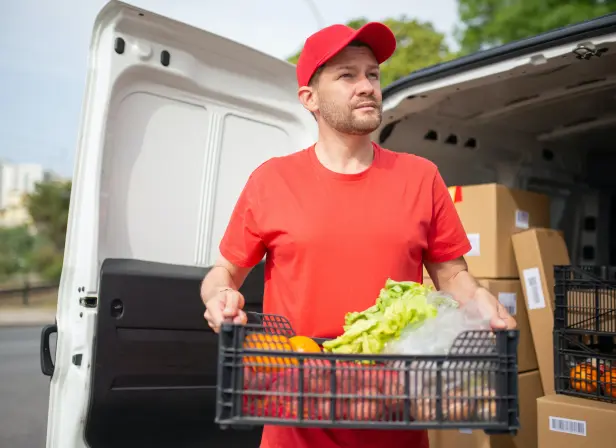Best Practices For Local Grocery Delivery In 2025

Grocery delivery demand is booming, but customer expectations are higher than ever. These proven strategies help you deliver better service profitably.

- Customer experience wins: Transparent pricing, multiple delivery options, and responsive support separate great services from mediocre ones.
- Technology streamlines everything: Route optimization, real-time tracking, and automated communications cut costs while improving service quality.
- Freshness drives loyalty: Cold chain management and speed matter more than ever as customers expect restaurant-quality produce at their door.
- Cost control determines survival: Smart routing, supply chain optimization, and strategic partnerships keep margins healthy in a competitive market.
- Data beats guesswork: Track customer behavior and delivery metrics to make decisions that actually improve your bottom line.
Demand for grocery delivery is still growing:
- Worldwide, grocery delivery market revenue is projected to grow by 9.7% each year from 2025-2029.
- By 2030, 2.3 billion people are expected to be ordering groceries online for delivery.
Local grocery delivery is becoming an important part of many consumers' lives. From reducing time spent at the grocery store to making sure you get your hands on hard-to-find ingredients, a convenient and reliable local grocery delivery service can be a game-changer for busy households.
But not all local grocery delivery services are the same. The best ones focus on safety and convenience while offering competitive prices. With that in mind, here are the best practices your grocery e-commerce store should consider in order to capture more of the grocery market share.
hile offering competitive prices. With that in mind, here are the best practices your grocery e-commerce store should consider in order to capture more of the grocery market share.
Trends in local grocery deliveries for 2025 and beyond
The grocery industry has changed dramatically in the past few years. From new trends in online ordering to the emergence of grocery delivery services, local groceries have been shifting away from traditional shopping experiences to meet modern demands.
In 2025, these changes will continue as consumers demand more convenience and safety during shopping trips. Here's an overview of some of the top trends shaping the future of local groceries.
Online is still growing
The global market for online grocery delivery is expected to grow at a compound annual growth rate (CAGR) of 26.8% from 2023 to 2030. Customers are becoming comfortable with ordering groceries online. So local grocers have to be ready to provide an easy and secure shopping experience for customers.
That means offering a well-designed website where users can search for items, add them to their cart, and check out quickly and securely. It also means keeping up with the latest trends in online ordering. For example, contactless payment and automated order confirmations are becoming more popular.
Consumers are looking for ways to save money
Grocery buyers continue to face notable inflation in 2025, though the rate has slowed compared to 2022 and 2023. In the United States, grocery prices rose 2.2% from May 2024 to May 2025. Supply chain disruptions, increased transportation costs, and tariffs on imported goods continue to push prices higher, with meat, vegetables, and fruits seeing the biggest increases due to weather events and global commodity volatility.
Consumers are responding by fundamentally changing how they shop. In the U.S., 88% of consumers report changing their grocery routines, with 44% choosing generic or store brands and 38% avoiding impulse purchases.
Discount and wholesale channels have seen increased traffic across all age groups, with 80% of Gen Z consumers shopping at wholesalers in the previous month. Many are using coupons, buying in bulk, and trading down to more affordable alternatives.
Despite these adaptations, grocery affordability remains a major stress point — 61% of U.S. consumers express concern about their ability to afford groceries, and food bank visits in Canada have reached record levels.
Brace for even higher customer expectations
As technology advances, customers' expectations for their grocery shopping experience also evolve. With apps like Instacart, shoppers are able to order groceries with a few taps of their phone. While delivery services like DoorDash offer even more convenience by bringing items right to the door.
Technology advancements have made it easier for customers to get what they need quickly and efficiently. This trend is rising as shoppers expect more from their local grocers - from competitive prices to faster delivery times. In short, local grocers should expect higher customer expectations in 2025.
Sustainable deliveries can give you an edge
Sustainable deliveries have become increasingly popular in recent years as shoppers look to reduce their carbon footprint while they shop. Local grocers can use this trend to stand out from other grocery delivery services. This may include offering eco-friendly packaging and utilizing electric vehicles for deliveries.
By utilizing sustainable delivery practices, local grocers can prove their commitment to environmental stewardship and give their customers the confidence that their purchases are not negatively impacting the planet — a major win in 2025.
4 grocery delivery best practices to implement now

Now that we've covered a few of the major trends in local groceries for 2025, it's time to look at some best practices that you should consider implementing as soon as possible. Here are a few tips that can help you provide an exceptional delivery experience for your customers:
Make customer experience your first priority
The key to success lies in ensuring that customer experience is their first priority. To do this, grocers should make a virtue of being local - by being accessible and responsive to their customers' needs. For example, grocers can offer customer support via phone, email, or chat to help customers make the most of their shopping experience.
Grocers will also want to make sure all information about delivery costs, estimated time of arrival (ETAs), time windows, and other relevant details are made available upfront. For example, automated text messages that specify when a delivery will be made, how it will be packaged, and how customers can track it can make the process much smoother for everyone involved, plus offer a competitive edge over other services.
Additionally, grocers should strive to offer multiple options for delivery and in-store or curbside pickup so that customers can choose what works best for them. This allows customers to choose the delivery option that best suits their needs - whether it's for convenience, cost savings, or both.
Optimizing omnichannel technology is one of the most critical grocery delivery best practices that local grocers should implement in 2025. To do this, grocers must first ensure their order management system is up-to-date and compatible with current customer demands. This means being able to accept online sales and payment through a variety of methods (credit card, PayPal, etc.) and having a secure checkout process from beginning to end.
Additionally, grocers should also focus on optimizing their delivery management system by utilizing real-time tracking for deliveries and efficient route optimization for drivers. For example, with Routific, grocers can use our texting and mobile apps technology to automate delivery planning and route management, allowing drivers to deliver more efficiently while also reducing the time customers wait for their orders.
Focus on freshness
Having fresh produce is essential for any grocery business that wants to improve its user experience. To do this, grocers should strive to maintain a cold chain from store to doorstep to ensure customers receive their items in perfect condition. This means investing in temperature-controlled packaging and delivery methods that utilize real-time tracking technology so that grocers can monitor the entire process from start to finish. This ensures that your perishable produce stays fresh, avoiding any spoilage happening to your grocery orders.
Additionally, grocery retailers must also prioritize speed and efficiency when it comes to delivery times. To achieve this goal, grocers should consider offering multiple delivery options (such as same-day delivery or next-day delivery) as well as providing customers with an estimated time of arrival (ETAs). By focusing on these two key areas - freshness and speed - local grocers can ensure they are staying ahead of the competition and providing their customers with an exceptional online grocery shopping experience.
Be the boss of your costs
Lastly, you'll want to stay on top of your operational costs and expenses when it comes to grocery delivery. To do this, grocers should focus on streamlining their supply chain processes and leveraging technology to reduce the costs associated with home delivery. For example, grocers can use delivery optimization software to automate route planning and management, saving time and increasing profitability while also ensuring orders are delivered quickly and efficiently.
Grocers can also consider partnering with a local delivery service that offers more cost-effective services and a better overall customer experience.
Learn from the best
If you want to learn to be competitive in the grocery delivery market, look at the experts. Major retailers like Amazon, Instacart, and Walmart can provide examples of best practices. Bigger chains compete on a larger scale, which smaller stores may not be able to compete with. However, there are still plenty of lessons smaller businesses can learn from them.
Data-driven decisions
One of the key advantages that major grocers have over smaller local ones is their ability to leverage data-driven decisions. This means using customer data to make decisions about everything from pricing strategies to customer service processes. With access to powerful analytics tools, you can track customer behaviors and preferences so that you can tailor your services accordingly. By analyzing customer data, you will be able to identify areas where you need improvement or expansion and adjust your strategy accordingly.
Streamline processes
To compete with larger grocery stores in 2025, it's important to make your delivery operations as efficient as possible. Invest in technologies such as automated ordering systems, route optimization sboftware and quick delivery methods. This will help orders be processed accurately and cost-effectively. It is also important to train staff on safety guidelines. For example, social distancing and contactless delivery keep customers safe and deliveries efficient.
Focus on creating loyal customers
Finally, it's important to remember that customer loyalty is key to success in the grocery delivery market. The biggest advantage that local grocers have over larger retailers is their ability to provide personalized customer service experiences. This is something that no amount of technology can replicate. Excellent customer service is essential to delivering an exceptional experience to customers. This includes having friendly, knowledgeable staff and delivery drivers who are punctual. Larger retailers may not be able to guarantee this due to their size and scope of operations.
Wrapping it up
In 2025 local grocers need to be prepared for the upcoming changes in the grocery delivery market. Local grocers can stay competitive in this growing market by focusing on freshness and speed of delivery, streamlining processes and leveraging data-driven decisions, investing in technology, and providing excellent customer service experiences. With a focus on customer loyalty and the right strategies in place, local grocers can continue to offer a unique, personalized service that customers will value and appreciate.
Frequently Asked Questions
Related articles
Liked this article? See below for more recommended reading!

How To Grow Your Online Grocery Delivery Business

How To Work Towards Zero-Waste Grocery Delivery


